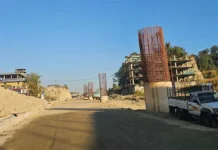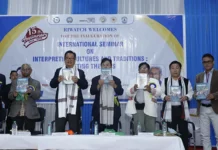[ Tongam Rina ]
ITANAGAR, Jul 24: The Idu Mishmi Cultural and Literary Society (IMCLS) has said that National Hydroelectric Power Corporation (NHPC) Limited should withdraw its petition which is currently in the High Court opposing grant of compensation to community land that comes under unclassified state forest (USF) pertaining to 2880 MW Dibang Multipurpose Project.
While speaking to this daily, IMCLS president Ginko Lingi said that it would have no option other than filing a case against the NHPC if the corporation refuses to pay compensation to the people which are due to them.
Lingi said that if the NHPC has to start work, it has to grant compensations to the affected villagers.
The Society which is the apex organization of the community said a formal letter requesting the NHPC to withdraw the writ petition is being worked out.
NHPC Petition challenging community land
NHPC has filed a writ petition in the high court -WP (C) No. 132 (AP)/2019 challenging the legality of the compensation of Rs 1601, 39, 31, 725/ for “farcical acquisition of 1732.432 Ha of unclassified state forest (USF) land in Dibang Valley”.
During a supplementary affidavit filed after one of the project affected people approached the court, NHPC stated that the indigenous people living in the surrounding areas of the acquired land have only traditional/customary rights over the USF land, which they enjoy collectively on community basis.
Several people have since gone to the High Court with application, impleading that they be made defendants in the case as they are directly affected by the position taken by the NHPC. On Wednesday, a group of people affected by the NHPC writ petition filed an application. The court will take a decision within two weeks whether to accept their application.
The Dibang Multipurpose project affected area committee led by its president Athupi Melo has already written to the IMCLS seeking their intervention in the NHPC’s case.
While speaking to this daily, Melo said that NHPC’s move is an attempt to deprive the people of their rights.
“We resisted against the project. All attempts to have public meetings were thwarted by us from 2008. When we finally agreed in 2013, we were under the impression that the NHPC will respect our land rights and ownership”.
He says that people who are directly affected by the project will not keep quiet as the decision not to recognize community land which is termed the unclassified state forest will directly affect all the indigenous communities in the state and deprive them of their rights.
Dibang Multipurpose project affected area committee has said that NHPC has to stop all activities till matter is resolved by the court.
In a letter written to the Deputy Commissioner of Dibang Valley last September, NHPC makes it amply clear that indigenous tribal people cannot claim unclassified forest as their own.
According to preliminary notification by the state govt for land acquisition, the community land identified for the project are Kano/Akaya, Anaya, Amili, Alili, Eprali, Arzo/Endipo, New Endolin, Gunli, Isuli, Ryanli/Lopo/Inchindo, Amrali Amuli, Apako, Ataya, Mrambo upper, Kronli, under Arzoo circle.
The other villages are Aprunli, Emrali, Angolin in Etalin circle and Angapo, Aneli/Brito, Ichili/Ginli and Wanli under Anelih circle.
Though there has been no classification on the land ownership pattern, in Arunachal, unclassified state forests are the community owned land of the indigenous communities which makes up for more than 60 percent of the total forest cover.
Govt illegally acquired land, may abandon the project, NHPC says
In February 2019, the Secretary, Land Management wrote to the deputy commissioner, Dibang Valley informing about the state government’s approval of land acquisition for the project.
However, even after approval by the state government, the NHPC filed the writ petition regarding the compensation.
After it filed the case, in a letter to Deputy Commissioner, Dibang Valley district, in June, NHPC stated that the fate of the project depended on the outcome of the court verdict.
NHPC states that “the entire land illegally acquired by the Government of Arunachal Pradesh in a sham proceeding for the Dibang Multipurpose Project is in fact part of the USF land for which the Government of India has given its in principle approval for diversion under the Forest (Conservation) Act, 1980. Under the extant law, the diversion of USF land can only result in loss of traditional or customary right of tribal community living in the surrounding areas and there is no question of loss of any individual right because USF land does not belong to any individual as it is not a private land”.
NHPC said that it may abandon the project because “in principle it is against paying an unreasonably astronomical amount the compensation for sham acquisition of USF land for the project”.
In the letter, NHPC accused the state government of “illegally acquiring land, acting beyond is jurisdiction, in defiance of all the rules regulations policies agreements”.
Implication of the writ petition
Many fear that if the court verdict goes in favour of NHPC, it will have devastating impact on the land ownership pattern of the tribal communities of the state.
The petition by the NHPC, a govt of India undertaking questions the very basic land rights of the indigenous communities, says a lawyer.
This case will have implications across the state if the court gives an order in favour of the NHPC; the lawyer says questioning the intent of the NHPC which has several projects has lined up in the state.
“NHPC has to pay for loss of resources as well as the land compensation”, says Melo stating that the corporation did not put any objection till it was time to pay compensation.
“Ironically, the forest dept is one of the respondents. It is on the government of Arunachal and the forest department to take a position unless they want to make the entire indigenous communities landless in the name of development. Community land belongs to the people, it never belonged to the state or the NHPC”, says a lawyer.
Unclassified state forest is community land, says Melo.
Paving way for world’s tallest concrete gravity dam
On July 17, Cabinet Committee on Economic Affairs, which was chaired by Prime Minister Narendra Modi approved the 2880 MW Dibang Multipurpose Project, paving way for the construction of the world’s tallest concrete gravity dam without the final forest clearance. The height of the dam will be 278 metres.
Rs 1600 crore is the approved expenditure for pre-investment activities and various clearances for Dibang Multipurpose Project.
The estimated completion period for the project has been fixed at nine years from receipt of government sanction and the estimated total cost of project is Rs 28080.35 crore.
Project yet to get final forest clearance
While all statutory clearances, including environment clearance, forest clearance (Stage-l) defence clearance and techno-economic clearance has been granted, the stage-II forest clearance is yet to be accorded.
The total land requirement for the project is about 5349.14 ha, which includes unclassified state forest, community land, and wet rice cultivation areas.
The total submergence area is 3564 ha, which includes 1176 ha of river bed. The total catchment area of the project is 11,276 sq kms.
Rs 500.40 crores has been projected for compensation for land acquisition and relief & rehabilitation (R&R) activities to project affected families and state government, payment of net present value of forests, compensatory afforestation, catchment area treatment plan to the state government for forest lands, to secure the forest clearance (Stage-lI) and construction of roads and bridges for accessing project site.
In addition to the mandated R&R plan, it is also proposed to spend Rs 241 crore on community and social development plan and certain concerns raised by the local people during the public hearings.
An amount of Rs 327 lakhs is proposed on a plan for protection of culture and identity of local people.
According to studies, 115 families of five villages are likely to be displaced, and 744 families of 39 villages are likely to be affected due to acquisition of land.




